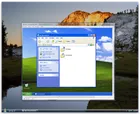There are a couple of ways by which you can backup your documents, photos, emails and other important files that on your home computer. For instance, you may:
1. Use an external drive – You can attach an external hard disk to your PC or Mac through the USB port and use the built-in software to backup all your important files and folders automatically. These devices are sleek, portable and some even have FireWire ports so the data transfer happens at a much faster rate.
2. Clone the computer – You can use disk imaging tools like Acronis True Image or DriveImage XML (free for personal use) to create an exact mirror image of your hard-drive. The tools will even backup your system files and program settings so you can easily restore the computer to a working state in case your hard-drive crashes.
PS
you are using Windows 7, you don’t really need any of these tools as the OS itself has a backup tool that will let you create system images at any point of time. You can store these snapshots on another partition of the same hard-disk or you may use an external drive.3. Backup to another computer – If you have two or more computers connected through a home network, you can use the hard disk of one computer to store the data of another computer and vice-versa.
Microsoft Sync Toy is an excellent program that can help you keep folders across computers in sync with each other and thus can be used an indirect backup tool.
Alternatively, you may consider using desktop based backup software programs like FBackup or GFI Backup that are free for personal use and allow you to easily backup your files to any other computer on the home network (LAN). You can even schedule backups so that they run automatically at pre-defined intervals.
While FBackup has a more clean interface, GFI Backup offers both differential and incremental backups which are naturally faster than full backups. Both software programs can compress files on the fly so that your backups occupy less space on the network drive.
 4**. Create a Virtual Machine** - Microsoft offers a free utility called Disk2vhd to help you create a virtual machine of your Windows PC.
4**. Create a Virtual Machine** - Microsoft offers a free utility called Disk2vhd to help you create a virtual machine of your Windows PC.
You can copy the virtual machine file to another computer and access programs, documents and other files using Microsoft Virtual PC or any of the free virtualization software.
5. Use Offsite Backup - All the options discussed above make data backup easy but they obviously are not hands-free. You may therefore consider storing your data in the cloud use an online backup service.


